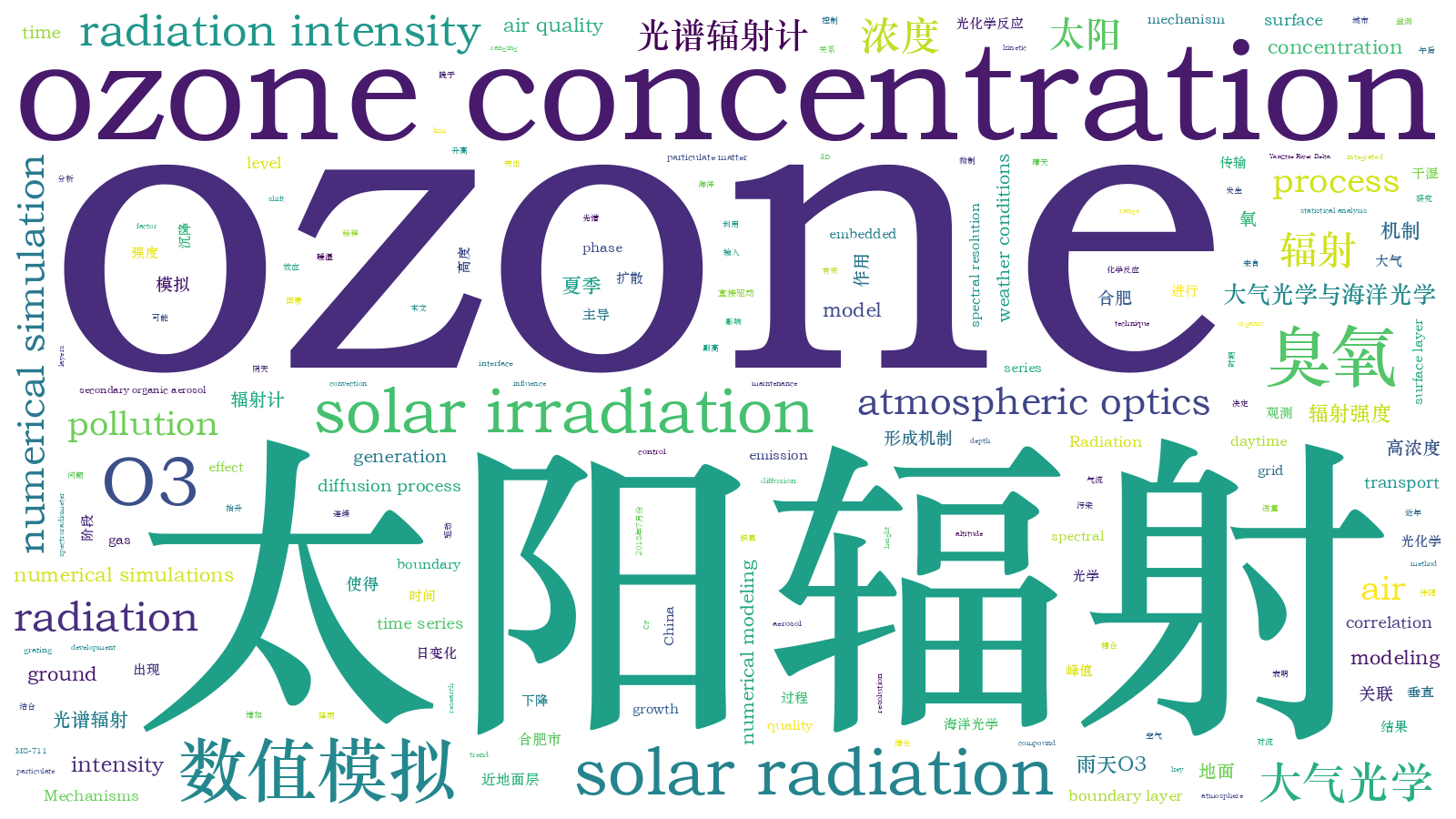对合肥夏季臭氧的数值模拟:太阳辐射及其关联机制的作用
In recent years, many cities in China have gradually changed from single-type particulate matter pollution to compound air pollution, with increasingly prominent ozone pollution in summer especially. The Yangtze River Delta where Hefei City is located is the region with the most serious ozone pollution in summer. Thus, we analyze in depth the changes in summer ozone concentrations and solar radiation intensity in Hefei by combining two experimental methods of observational analysis and numerical simulations to understand the possible correlations between them. Numerical modeling is also adopted to reproduce the daily variations in solar radiation intensity and ground-level ozone concentrations in different weather conditions. The contribution of each physicochemical process to ozone production is quantified by the process analysis techniques embedded in the model, and the details of the influence of gas-phase chemistry, dry and wet depositions, and diffusive transport on ozone concentrations in different weather conditions are distinguished. Our study is expected to explore the effect of solar radiation on ground-level ozone concentrations with the help of sophisticated observations and effective simulations to deepen the understanding about the intrinsic mechanism of solar radiation directly and indirectly affecting ozone concentrations. Finally, we can analyze the causes of urban ozone pollution in summer in a more scientific manner and provide a necessary theoretical basis for the effective prevention and control of ozone pollution.
MS-711 is a new generation of all-weather grating spectroradiometer, which measures in the spectral range of 300-1100 nm with a spectral resolution of less than 7 nm. The data for the air quality model are obtained from the final operational global analysis (FNL) project, and the emission inventory of the pollutant sources is provided by the multiresolution emission inventory model for climate and air pollution research (MEIC). The ozone concentration data are obtained from the Hefei Ambient Air Quality Monitoring Station. WRF v4.1 and CAMx v7.10 are utilized for the numerical modeling of meteorological fields and air quality. The model employs a three-layer nested grid with grid side lengths of 27, 9, and 3 km, ranging from Northeast Asia, Eastern China, and Hefei City and its surroundings respectively. The WRF microphysics is the Morrison double-moment scheme, and the cumulus parameterization is the Grell 3D ensemble scheme. The gas phase chemistry mechanism of CAMx is CB05, and the secondary organic aerosol scheme is CF. We also leverage time-lagged correlation analysis (TLCC) to assess the relationship between solar radiation intensity and ground-level ozone concentrations. Meanwhile, TLCC is adopted to calculate the correlation of one time series with another at different points in time. We shift the ozone concentration series backward by a certain amount of time and then calculate the correlation coefficient between it and solar radiation intensity. The integrated process rate analysis (IPR) method is a process analysis technique that combines chemical kinetic modeling and statistical analysis methods embedded in the CAMx model. Additionally, we employ it to analyze the effects of a variety of chemical reactions and physical processes on ozone generation and elimination rates to determine the rates and understand the ozone generation and elimination mechanisms.
The observations and numerical simulations confirm that the zone peak of summer daytime occurs approximately 2-3 h after the peak solar radiation intensity (Fig. 3). From layer 1 to layer 5, the ozone concentrations increase gradually with the rising height (Fig. 5). The contributions of ozone sources in the near-surface layer (layer 1) are as follows. The vertical diffusion process from high altitude to the ground contributes a generation rate of +8.87×10-9 h-1, which is a main reason for ozone concentration increase, while the contribution of dry depositions is -8.12×10-9 h-1 and it is the main ozone scavenging process (Fig. 6). Layer 6-layer 7 correspond to altitudes of 1931-3371 m, and the main reason for low ozone concentrations is due to the rapidly decreased contribution of photochemical processes (Fig. 5). The ozone accumulation on sunny days comes from photochemical processes first, and when the solar radiation intensity decreases, the large input of ozone generated in the upper part of the boundary layer is the key factor in maintaining the ozone concentrations. However, the ozone concentrations maintain a slowly decreasing trend in the following hours due to the convection development in the late afternoon, which blocks subsidence [Fig. 7(a)]. On rainy days, Vc (contribution of chemical processes) values are small, slowly coming, and short-lived, while the significantly enhanced Vtp (contribution of diffusive transport at the upper interface) throughout the afternoon hours is the primary reason for the growth and maintenance of ozone concentrations [Fig. 7(b)]. On cloudy days, solar radiation dominates the ozone growth stage, and dry and wet depositions and horizontal fluxes dominate the ozone decline stage [Fig. 7(c)].
The vertical motion of the atmosphere exerts a significant effect on near-surface ozone concentrations. The ozone concentrations gradually increase from the ground up to approximately 1 km, with a positive contribution from the downward movement of the air that transports the high ozone concentration in the upper layers to the near-surface during sunny days and a negative contribution from the upward movement of the air that dilutes the ozone concentration in the air below the boundary layer during rainy days. The daily variations in ozone concentrations in different weather conditions are closely related to the contribution of several mechanisms. Solar radiation-driven photochemical reactions, diffusive transport, and wet and dry depositions affect ozone production at different moments and altitudes, and the process analysis results show that the quantitative contributions can explain the daily variability of ozone concentrations characterized by different weather conditions.
易明建, 黄雪梅, 姜永清, 赵强, 李艺, 邓淑梅. 对合肥夏季臭氧的数值模拟:太阳辐射及其关联机制的作用[J]. 光学学报, 2024, 44(6): 0601011. Mingjian Yi, Xuemei Huang, Yongqing Jiang, Qiang Zhao, Yi Li, Shumei Deng. Numerical Simulation of Summer Ozone in Hefei: Role of Solar Radiation and Its Associated Mechanisms[J]. Acta Optica Sinica, 2024, 44(6): 0601011.







